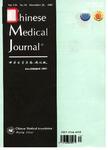In vivo distribution of c-myc antisense oligodeoxynucleotides local delivered by gelatin-coated platinum-indium stents in rabbits and its effect on apoptosis
In vivo distribution of c-myc antisense oligodeoxynucleotides local delivered by gelatin-coated platinum-indium stents in rabbits and its effect on apoptosis作者机构:Department of Cardiology Shenzhen Futian Hospital Guangdong Medical College Shenzhen 518033 China Department of Cardiology First Hospital of Xi'an Jiaotong University Xi'an 710061 China
出 版 物:《Chinese Medical Journal》 (中华医学杂志(英文版))
年 卷 期:2004年第17卷第2期
页 面:258-263页
核心收录:
学科分类:1002[医学-临床医学] 100201[医学-内科学(含:心血管病、血液病、呼吸系病、消化系病、内分泌与代谢病、肾病、风湿病、传染病)] 10[医学]
主 题:coronary restenosis gene therapy stents platinum-iridium alloy
摘 要:Background Post-stenting restenosis is a significant clinical problem, involving vascular smooth muscle cells ( VSMCs) proliferation and apoptosis. It is reported that c-myc antisense oligodeoxynucleotides (ASODNs) local delivered by catheter can inhibit VSMCs proliferation. This study was designed to assess tissue distribution of c-myc ASODN local delivered using gelatin-coated platinum-iridium (R-lr) stents, and its effect on apoptosis of VSMCs. Methods Gelatin-coated Pt-lr stents that had absorbed caroboxyfluorescein-5-succimidyl ester (FAM) labeled c-myc ASODNs (550 μg per stent) were implanted into the right carotid arteries of 6 rabbits. Tissue samples were obtained at 45 minutes, 2 hours, and 6 hours. Tissue distribution of c-myc ASODNs was assessed by fluorescence microscopy. In addition, 32 rabbits were randomly divided into two groups. Rabbits in the control group (n =16) were implanted with gelatin-coated R-lr stents, and those in the treatment group (n =16) were implanted with gelatin-coated stents that had absorbed c-myc ASODNs. 7, 14, 30, or 90 days (n =4, respectively, for each group) after the stenting procedure, the stented segments were harvested, and histopathological examinations were performed to calculate neointimal area and mean neointimal thickness. The expression of c-myc was assessed using in situ hybridization (ISH) and immunohistochemical methods. Apoptotic VSMCs were detected using terminal deoxynucleotidyl transferase mediated dUTP nick end labeling (TUNEL) and transmission electron microscope (TEM). Results According to fluorescence microscopic results, FAM-labeled c-myc ASODNs were concentrated in the target vessel media at the 45 minutes time point, and then dispersed to the adventitia. Morphometric analysis showed that neointimal area and mean neointimal thickness increased continuously up to 90 days after stent implantation, but that total neointimal area and mean neointimal thickness were less in the treatment gr



